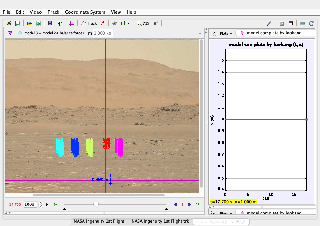

About
For Teachers
- NASA ingenuity flight video.mp4
Credits
Document Brief: Title: Tracker Computational Thinking Example: NASA Ingenuity's First Flight Dynamic Model
This document outlines a computational thinking approach using Tracker to analyze and model the first flight of NASA's Ingenuity helicopter on Mars. Through video analysis and step-by-step modeling, learners can explore the physics behind vertical lift, acceleration, and Martian gravity.
Study Guide:
Objective:
-
Use Tracker video analysis to model and analyze NASA Ingenuity's first flight.
-
Apply computational thinking to understand motion under Martian gravity.
Key Concepts:
-
Video Calibration and Coordinate Setup:
-
Setting scale using rover references or landing site features.
-
Choosing appropriate origin and axis directions.
-
-
Marking and Modeling Motion:
-
Frame-by-frame tracking of Ingenuity's center of mass.
-
Identifying lift-off, hover, and landing phases.
-
-
Modeling Gravity and Lift:
-
Setting Martian gravity (~3.721 m/s^2).
-
Modeling upward thrust and balancing forces.
-
-
Data Analysis:
-
Velocity-time and displacement-time graph generation.
-
Identifying periods of constant velocity and acceleration.
-
-
Computational Thinking Elements:
-
Decomposition: Breaking the flight into distinct phases.
-
Abstraction: Ignoring minor vibrational motion.
-
Pattern Recognition: Identifying similar motion patterns.
-
Algorithm Design: Step-by-step tracking and modeling procedure.
-
Step-by-Step Process:
-
Import Ingenuity flight video into Tracker.
-
Calibrate scale using a known length (e.g., Ingenuity's rotor span).
-
Set coordinate system with appropriate origin and axis.
-
Mark center of mass frame-by-frame during takeoff, hover, and landing.
-
Create a dynamic particle model with Martian gravity.
-
Apply thrust during takeoff and hover phases to simulate motion.
-
Compare model trajectory with real data.
-
Analyze graphs and refine the model.
FAQ:
-
Can I analyze a flight on Mars using a video on Earth?
-
Yes, by adjusting gravitational parameters to match Mars.
-
-
What does Tracker help me understand?
-
It enables visualization of motion, forces, and allows theoretical model comparison.
-
-
How do I determine when thrust is applied?
-
By observing velocity changes and comparing with expected hover patterns.
-
-
Can Tracker be used for other planetary models?
-
Absolutely! You can adjust gravity and environmental factors accordingly.
-
-
How does this activity foster computational thinking?
-
It encourages breaking problems into steps, identifying patterns, and developing a model to solve complex real-world problems.
-
Conclusion: This Tracker-based activity helps students experience real-world applications of physics and computational thinking by analyzing NASA's historic Ingenuity flight. It bridges theoretical modeling with actual mission data, making abstract concepts more tangible.
Version:
https://weelookang.blogspot.com/2021/11/tracker-nasa-ingenuity-flight-video.html
end faq
{accordionfaq faqid=accordion4 faqclass="lightnessfaq defaulticon headerbackground headerborder contentbackground contentborder round5"}
- Details
- Written by Loo Kang Wee
- Parent Category: 03 Motion & Forces
- Category: 02 Dynamics
- Hits: 4600
